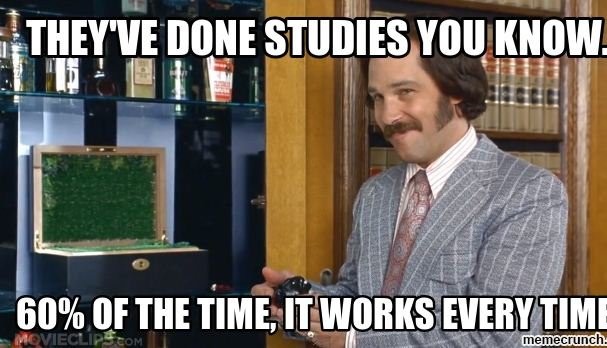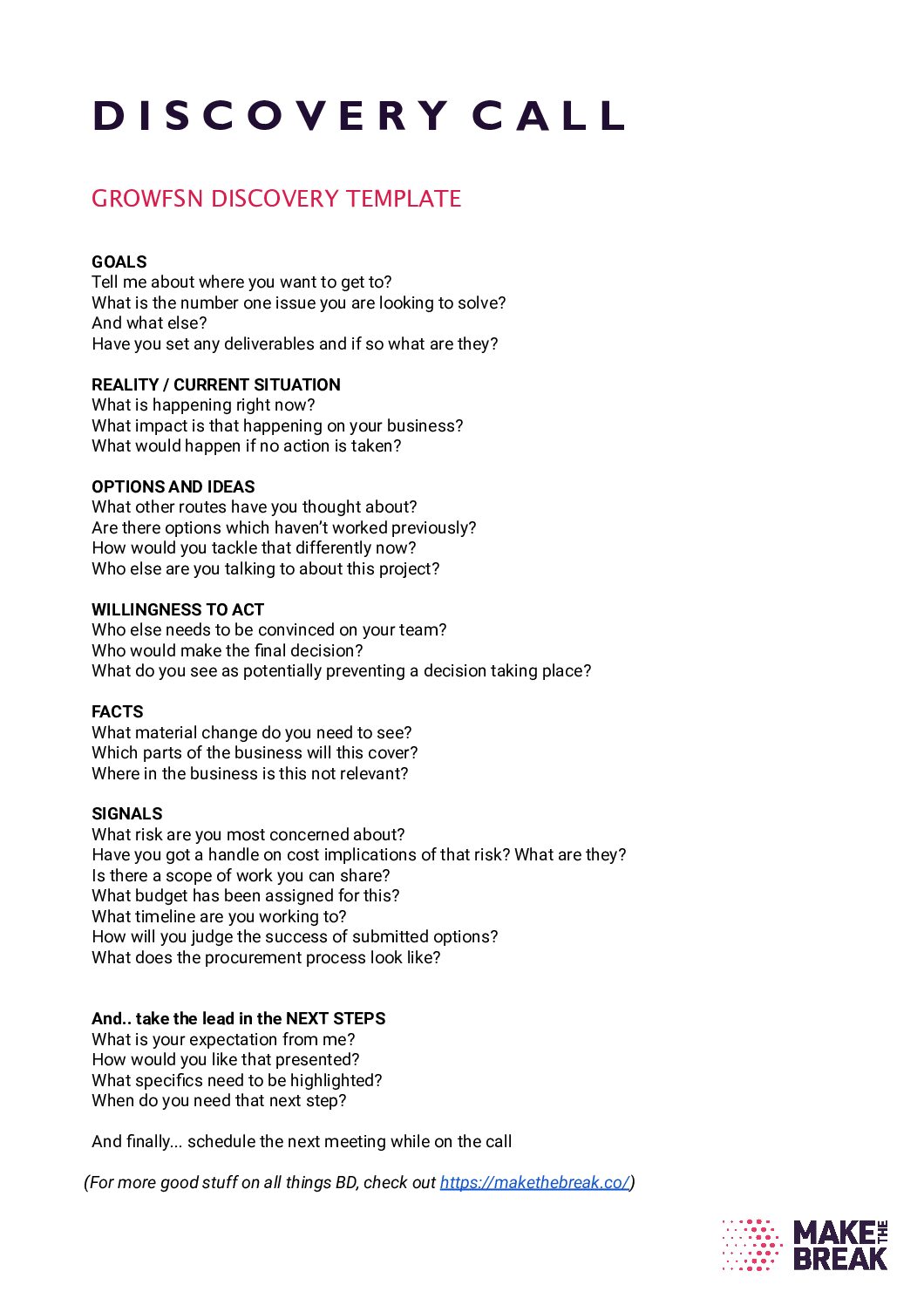
Stu Pringle
Director
Part 1 was all about putting some structure around the discovery call
In last month’s episode, the first of this two blog series, looked at a suggested structure for a sales discovery call. I presented the snappily titled GROWFSN model to keep things on track and prevent the chaos of going in without a plan and just wandering about in the call.
Part 2, this article is all about the approach to accompany the structure
A definition of ‘the approach.’ For the purposes of today it covers all the other stuff, mindset, speed of speech, how much you want to share, how much vulnerability to show.
Lob all that in a pot together to make ‘the approach.’
Why all this together? Because each element matters and can greatly influence the end result. The downfall of having a mix of elements under one title? It’s less tangible than things you can pick up and hold, like a calling template.
If you can go with that, then read on…
Be kind to yourself
Here’s the first thing to grab on to. Do not expect to become a discovery god on your first call. Like all skills this takes time to master. I truly believe it is one of those things where the real craft only comes as a result of being ‘on the tools’ over an extended period of time. Not only does it take time, but even the experienced don’t get it right every time. I can clearly recall calls in the not too distant past that I would happily put in the category ‘car crash.’ It happens, don’t beat yourself up. A side note to this. There’s pretty much a direct line connecting those unsuccessful calls with how exhausted I was on the day. Not exactly rocket science to both figure that out and avoid it in future.
60% of the time…
A little bit of prep goes a long way
One of today’s traps is back to back to back calls. Going from one to the other without the time to properly switch gears, makes it (for me at least) super hard to give each call the focus it deserves.
Quite simply, I cannot be at my best without a gap between calls.
Not having the gap means that any chance of preparation goes out of the window. And that little bit of prep can go a long way. A few minutes research on the key people on the call (how long in post, former roles, professional past) AND a few minutes on the company (recent news, sectors, locations etc) is valuable both for navigating the call and elevating you among the sales experience from others.
Try it.
Avoid the jargon
I found early in my career that when I was nervous, I would resort to management speak jargon. Particularly if I assessed that at least one of the other people on the call were super senior (hereafter termed ‘a big dog.’)
Here’s the thing. That nervousness can be spotted a mile out. It’s not a good look. Instead, just speak normally.
I’ve discovered that by staying away from the synergies and avoiding any helicopter views, most people, big dogs included, respond well to it. Be that breath of fresh air and get into the topic like a normal human being.
And shhhhh here’s the thing, maybe, just maybe, those hiding behind management speak at the other side of the table are also fronting because they don’t know what’s going on either.
GROWFSN template
Here is a GROWFSN template just for you. Got a better name for this..? My DMs are wide open.
Get your copy
Grab a free GROWFSN template. Try it out and see how you get on. Tell us what happens and if you find useful.
Two ears, one mouth
If someone on your team is deep into a call with a prospect and they are doing ALL the talking then we have a problem. I have seen this time and again when the sales person comes off the conversation thinking, score, while the prospect has just had their ears battered for 45 minutes. A promising discovery session should involve lots of listening from the sales person. That means the prospect is opening up. And in turn, there’s the gold to find out if this is potentially the right fit. There’s a stat from Gong.io on this that is a few years old but is pretty robust. After analysing 25000+ sales calls they found the ideal talk to listen ratio was 43:57.I’d go further, 33:66 is where the good stuff lies.
Are you nodding along while reading this?
Don’t bullsh*t
This is the natural evolution of not being nervous and avoiding the jargon. Don’t bullsh*t while on sales calls. What I mean by this is if someone goes into some technicality or industry specifics and they ask you if you know about it – and you don’t – do not be that person who goes along with it and says ‘yeah I know all about it.’ Why? You’ll probably get found out for one. And also, showing a bit of vulnerability is a good thing. It’s another way of showing you are a properly well rounded human being and not a sales bot. And you know what, if the person on the other side has even an ounce of passion about what they do, they will very likely enjoy sharing the knowledge with you.Go slow
Speak slowly for the win. I am a terrible one for speaking fast when it’s not going to plan. Just like public speaking, speak slowly when on a sales call. Give people time to reflect on what you are saying. Leave some room for them to get into the call (see the power of silence coming up next) This is another one that hits the ‘don’t come across nervous’ goal. I believe it is an important step in positioning yourself as peer to peer, especially with big dogs. Being peer to peer is a crucial step to coming across as a credible partner.
Book now to give your business a health check
Our health check will shine a torch around the inside of your sales and marketing set up.
We will identify frictions and highlight what support would help.
The power of silence
This is all about not jumping into a gap in the conversation, just for the sake of filling it. While it may seem awkward at first, leaving gaps is a good idea.
This is not new thinking. You’ll likely have seen this recommended by many others. The power of silence was one of the things I learned from going through Sales training when back at Sift Media.
I am a big advocate of leaving gaps and not jumping in. Give the prospect time to think and wait for them to come out with the next thought which just might be absolute gold in understanding their situation.
Of course, this one does have the potential to backfire every now and then. I have been in a sales call when the other person also has had the training. A ‘silence off’ ensues. Who breaks first? I admit, I have been in this situation and done it by asking if they’ve had the training too…
Not going well? Call it out
Every so often despite best intentions, a call can feel awkward. If that’s happening I say call it out.
This doesn’t feel fun, sense there are other things on your mind… is now a bad time to have this chat?
I’ve found this approach not to be as risky as it might appear. Self sabotage? Nope. Better to find out what is really going on rather than bash on regardless. I’ve found more often than not this can lead to setting up a discussion on another day that tends to go well.
‘The magic questions
Along with some thoughts on do’s and don’ts with the approach, I thought I’d share some magic questions I’ve picked up through my career.
Tell me about..?
‘Tell me’ is the swiss army knife of questions. It’s an open question, encourages the sharing of knowledge. It doesn’t direct the prospect down a path they don’t want to go AND it sounds much more peer to peer than ‘asking for advice.’
In the hierarchy of question set royalty, Tell Me is king.
What’s important to you..?
This is for the pro’s out there. ‘What’s important to you?’ was shared with me one evening down at the banks of the Thames over a beer or three. It was handed over like a mystical secret from one battle hardened warrior to their apprentice. If you are reading this, you know who you are…
And I’m here to tell you, it’s been in use ever since. The ‘what’s important to you’ question is the very embodiment of this whole piece on the approach. Asked in a timid way with hesitation and uncertainty and it doesn’t fly. Asked with an air of confidence, let’s really get into what matters here… and it unlocks the really interesting info. The very info that gets played back in the exec summary of the proposal which flies straight up to the board for sign off.
How do you mean..?
Here is an opportunity to go that little bit further. Pick up on an element of the important and ask for more.
What’s your opinion..?
Not quite ready to bust out the full ‘what’s important to you?’ Well, why not try the JR version.
Asking for an opinion is less onerous than asking for advice.
And will all of these, combine them with a healthy bit of honesty. ‘I don’t know about X, tell me…’

